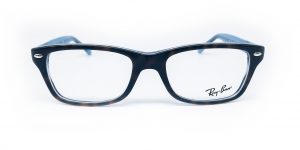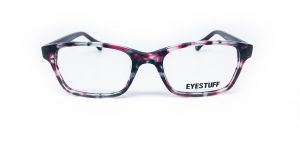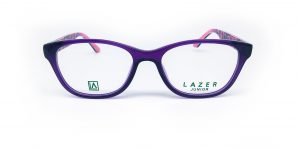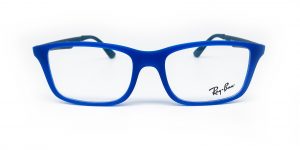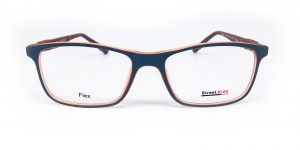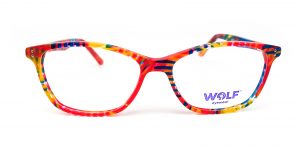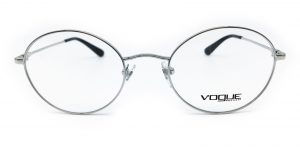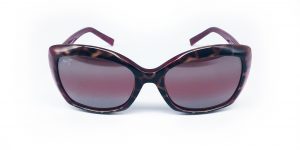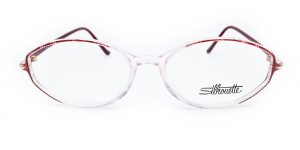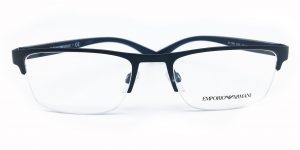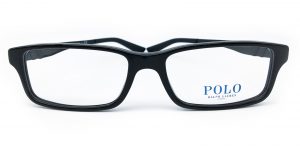Children’s glasses are anything but dull
Brilliantly bold or simple yet stylish – we have children’s glasses to fit all tastes and personalities.
Frames for children have come a long way in recent years, with a greater focus on comfort and style making them way more appealing to a younger audience than in years gone by.
If your child has been prescribed glasses, choosing a pair of frames they love will go a long way to making sure they wear them when they are meant to.
With so much choice available for our younger customers, we thought we would give you the lowdown on some of our favourite pairs which are sure to be a hit.
Ray Ban Junior
These dark tortoiseshell frames from Ray-Ban Junior are seriously stylish. Fantastic for older children who want a designer look that’s contemporary but not too showy.
EyeStuff
These feminine frames from Eyestuff are both fresh and funky, mixing mottled pink with darker tones for an up-to-the-minute look.
Lazer Junior
Stand out from the crowd with these striking purple specs from Lazer Junior. The psychedelic circle detail on the insides of the arms gives added appeal.
Ray-Ban Junior
Wow – these neon blue frames from Ray-Ban Junior are spec-tacular! Rectangular lenses and angled arms complete the look.
Street Kids
Opting for frames in a favourite colour can often help encourage children to wear their glasses. But if they tend to be more conservative in their style, a flash of colour with an otherwise sedate frame can be a great option. We have several styles in stock which take this approach, but our favourite are these matt grey frames from Street Kids which feature a flash of orange around the lenses.
A wide selection of our frames is now available to browse online, so you can pick out which pairs you would like to try on before you come in for your eye test. Take a look at our full range of frames.
Obviously, we don’t have all frames available at all times in all of our stores, but we are always happy to help, so if there’s a particular style you’re interested in, just let us know.
________________________________________________________________________________________________________________________________
If you have any concerns about your child’s vision please do give us a call today to book an appointment, as the earlier a problem is picked up the better. Eye tests can be carried out on children of any age – they don’t need to be able to read or even speak yet. It’s particularly important to carry out regular eye tests if there’s a history of childhood eye problems in your family. Free NHS sight tests are available for children under 16 and for young people under 19 in full-time education. Find out more on the NHS website.
Back to news articles
Taking Inspiration from Star Specs
Large frames, small frames, brilliantly bold designs – there is a pair of glasses out there to suit everyone.
And as many famous people have found, if you choose the right pair they can become recognisable in their own right.
Taking inspiration from people in the public eye can be a great way to help you choose your next pair of glasses.
So, we’ve searched our stock to find a selection of specs that we think would suit some famous glasses wearers.
Elton John
Known for his statement specs, we reckon that Elton John could really rock this brighter than bright pair of frames from Wolf. These glasses conjure up images of cocktails on a palm fringed beach and would fit perfectly with Elton’s star-studded lifestyle.
John Lennon
They may not be rose tinted but these round metal-framed glasses from Vogue certainly make us think of John Lennon, many of our ranges feature similar styles inspired by his classic eyewear. The shaping of this pair particularly suits people with a softly curving face.
Audrey Hepburn
No one carried off a pair of large-lensed sunglasses like the legendary Audrey Hepburn. We really love these tortoiseshell framed sunglasses from Maui Jim, and we are pretty sure Ms Hepburn would have too. Picture them worn with a wide brimmed sun hat and chunky earrings and you would certainly be heading towards the Breakfast at Tiffany’s vibe.
The Queen
For stately style we humbly suggest the Queen would approve of these frames from Silhouette. The monarch errs towards frames which are barely there with oval shaping. This pair accentuate the eyes beautifully without being showy and would be perfect worn at any occasion – from daily outings to Royal garden parties!
Harry Hill
Think of madcap comic Harry Hill and we bet his glasses are one of the first things that come to mind. Dark half frames fit perfectly with his fast-paced creative personality. This pair from Emporio Armani are a good match for Harry’s famous specs and would be great for anyone looking to accentuate the upper part of their face.
Louis Theroux
King of geek chic, documentary maker Louis Theroux wears heavy dark frames bringing focus to his expressions and his curiosity. We think this super stylish pair of Polo frames would definitely be on Louis’ wish list.
Did you know you can browse our extensive range of frames online? Once you have selected the pair – or pairs – you like, with just the click of a button we can have them ready for you to try on when you come in for your appointment.
And if you are thinking about choosing some new frames, take a look at our blog which offers advice on picking the right pair for your face shape.
Back to news articles
Brand Spotlight | Sea2see
Stylish, ethical frames at affordable prices? Sea2see offers exactly that.
You would never guess it, but Sea2see frames are made entirely from abandoned fishnets and ropes collected by fishing communities off the coast of Spain, making ethical eyewear a very real option.
The company was founded by François van den Abeele, an entrepreneur with a deep passion for oceans and nature.
He believed that waste plastic which is clogging up our oceans could be turned into raw material to produce everyday products. After much investigation and investment his company has achieved just that, creating premium eyewear with a conscience.
Subtle colouring and sophisticated shaping make the range perfect for the ethical consumer who doesn’t want to scrimp on style.
The range includes a selection of sunglasses alongside everyday frames and is sure to impress when you reveal what they are made of.
As the company’s website explains: “Sea2see is leading a change, hoping consumers will start understanding that waste can be transformed into premium products.
“Sea2see is more than a product, it’s a statement that anybody can wear with pride, because sunglasses will not change the world, but people that wear Sea2see will.”
The company has made a commitment not to use products of animal origin in its manufacturing and as a result the entire collection is vegan-friendly.
It’s hard to pick, but here’s our three favourite pairs of Sea2see specs.
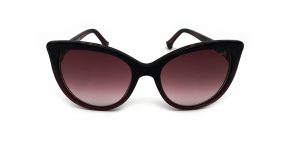
Think 1950’s chic with these Carmen sunglasses. The retro cat eye shaping of these frames will make sure you are always selfie-ready when you step out in the sun.

The Amalfi frame is subtly stylish. Bringing the recent ombre colouring trend to glasses frames, these specs would really suit someone who is looking to take a step away from the norm without going too bold.
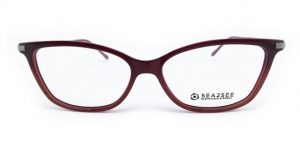
Sea2see has really come up trumps with the Taormina frame. This elegant piece is modern, yet classic and is sure to be a favourite with Patrick & Menzies customers.
You can take a look at all of the Sea2see frames we have in stock – alongside our other superb range of specs – on our website. Although we don’t have all frames available in all of our stores, we are always happy to help, so if there’s a particular style you’re interested in, just let us know.
Back to news articles
What are cataracts?
Cataracts are areas that develop in the clear lens inside your eyes, stopping light from reaching the back of the eye, and causing blurred or misty vision. They are not painful.
What are the symptoms of cataracts?
- Blurred, misty or cloudy vision
- Difficulty seeing in dim or low light
- Colours look faded or more like sepia
- Double vision
- Seeing haloes (circles of light) around bright lights, or finding lights too ‘dazzling’ to look at
- You feel like the lenses in your glasses are dirty or greasy, even when they are clean
Cataracts can develop very slowly and may not be noticeable for some time. They often develop in both eyes, although not necessarily at the same time or in the same way.
What causes cataracts?
Unfortunately, most cataracts simply develop as we age, although you can reduce your risk by eating a healthy diet and not smoking or drinking alcohol. If you have been exposed to frequent strong UV light, have taken steroid medication over a long period of time, or have had untreated diabetes you may also be at higher risk.
Can you tell me if I have cataracts?
We always check for the signs of cataracts during an eye examination. When we look inside your eyes to check their overall health, we look through the lens inside your eye. In doing so, any cataract or cloudiness will be visible to your optometrist. Other tests will also indicate the presence of cataract, in particular a noticeable drop in visual acuity (the size of the letters you can see on the chart) Most of the time, the vision can be improved by an alteration to the type of correction you have. Where this is not possible, we can discuss referral to an ophthalmologist for more tests and treatment.
Unfortunately, because there are no drops or medicines that improve cataracts, and your vision will deteriorate slowly over time, the only effective treatment is surgery.
What happens during cataract surgery?
Cataract surgery is the most common surgery in the UK and has an extremely high success rate. It is a quick and simple procedure which is carried out under local anaesthetic as a day patient, so you will be able to communicate with your surgeon during the operation.
The surgeon will make a tiny incision in your eye to remove the cloudy lens and replace it with a new, clear artificial lens. You will not normally need stitches, but your eye will be covered to protect it.
If you have cataracts in both eyes, you’ll need two separate operations, usually carried out 6 to 12 weeks apart to give the first eye time to heal.
So, will I need new glasses after my cataract operation?
After cataract surgery most people will still need to wear glasses for certain tasks, although the prescription will be very different from before the operation, and the vision should be markedly better. You will need an eye examination about a month after surgery once your vision has settled down.
If you’re at all concerned about cataracts contact us today.
Back to news articles
Using technology to better examine your eye health
For years the standard way of checking the health of the back of your eyes has been either direct ophthalmoscopy (when we get really close with the bright light) or slit-lamp ophthalmoscopy where you have your chin on a chin-rest and we look inside the eyes using a microscope, a bright light and a super-powerful magnifying lens.
All optometrists are highly skilled at recognising anything that may be wrong, the only problem with this is one of comparison. Judging whether the appearance of someone’s retina two or more years ago has changed or not, can be difficult, even when comprehensive notes are kept. That’s where photographs can be invaluable.
Many eye conditions can be particularly hard to detect because the changes in the appearance of the back of the eye can be very subtle and slow. If we take glaucoma as an example, the appearance of what’s called the optic disc, where the optic nerve joins the back of the eye, is one of the things that we monitor very closely. Glaucoma damages the optic disc and it’s shape and size change slowly as the damage occurs over time. If we have images to compare, then this damage can be picked up a lot earlier than would otherwise be the case. This is not just true of glaucoma, the detection of diabetes and other problems hugely benefit from this too. At Patrick and Menzies, we were early adopters of this technology, known as Fundus Photography over 15 years ago.
Since fundus photography became commonplace, a newer, more advanced technology became available, known as Optical Coherence Tomography or OCT. From the patient’s perspective the procedure is very similar to fundus photography. However instead of a flat 2D photograph of the retina, OCT uses scanning light beams to create a 3D image, not unlike an ultrasound, of the retina. The advantage of this is that we can see the deeper layers of the retina, nerve fibres and blood vessels underneath, things that can’t be seen on a conventional fundus photograph. Conditions like Glaucoma, diabetes and many others can be picked even earlier than before, enabling treatment before any significant sight loss or other complications can occur. We installed OCT in all our practices over 5 years ago and they have proved invaluable.
Our Braintree practice also has something called Optomap. These machines give us an ultra-widefield image of the back of the eye, enabling easier detection of any problems in the peripheral areas of the retina.
These more advanced ways of examining your eyes are a standard part of our private eye examination, and included if you are part of our VisionPlan scheme.
For anyone who receives a basic NHS check, they are available as an upgrade for a small fee.
For more information, or to book an appointment, just get in touch. We’d be very happy to look after you!
Back to news articles
Case Study | Mr Manton
The quick thinking actions of one of our optometrists proved to be life saving for our first-time customer Neil Manton.
Earlier this year Neil was driving home from Yorkshire in grey and rainy weather when he noticed a strange shimmering sensation in his right eye. Putting it down to tiredness, initially Neil wasn’t too worried, but when that shadow didn’t seem to go away after a few days he decided to book an appointment at Patrick & Menzies Braintree branch.
At Neil’s appointment our optometrist Charlotte Wearmouth listened carefully to Neil’s concerns and gave him a thorough examination which took almost two hours but couldn’t come to a definitive conclusion. Charlotte said, “Despite not finding any obvious cause, I was aware that Mr Manton’s symptoms were serious, especially as they developed suddenly and were not improving.”
Realising that the problem needed further investigation Charlotte sent the images of Neil’s eye and her findings to Broomfield Hospital with a request for them to follow up. Three or four days, later Neil was called into Broomfield for a further battery of tests, including a brain scan, which revealed that the carotid artery in Neil’s neck was 84% blocked, restricting blood flow to his eyes, and putting him at imminent risk of stroke or fatal heart attack.
Neil was admitted urgently for a 5-and-a-half-hour operation which resolved the issue and Neil was allowed home the following day.
Neil couldn’t be more grateful. “Patrick & Menzies are life savers! I really can’t praise them enough for the professionalism of the service I have received,” he says. “If Charlotte hadn’t been so thorough and taken so much time over my appointment when I went to her, I might not be here to tell the story today.”
Neil returned to Patrick & Menzies just six weeks ago for a further check-up and we are delighted to report that his eye health is even better now than it was before the operation.
Our eyes really are windows to our wellbeing, so if you have any concerns or notice any anomalies with your eyes or vision, please do make an appointment to see one of our optometrists today. We really do go the extra mile to make sure our patients stay well and happy and perhaps enjoy the odd game of golf, as Neil does!
Back to news articles
Brand Spotlight | Flexon
In 1961 US Naval scientists discovered that the metal alloy they were creating for missile heat shields automatically returned to its original shape, even after being hit with a hammer! This advanced memory material became the unique selling point of Flexon, which, since its launch in the US in 1988, has changed the world of eyewear with its unique attributes, building on the memory metal and further utilizing Japanese materials and technology.
Many brands have tried to imitate Flexon’s incredible success, but none have done so. That’s because Flexon frames feature technologically advanced memory metal in the bridge and/or temples allowing them to be flexed, bent or twisted and yet return to their original shape. Flexon frames require a minimal amount of adjustment but the nose pads and end pieces can be fine-tuned for a more custom fit.
Over the years Flexon eyewear has consolidated its design and manufacturing experience to create a varied collection filled with colour and comfort. Memory metal is combined with rubber, TR90 and stainless steel to make lightweight yet durable frames which allow the user to confidently go into any situation their busy lifestyle demands.
In 1997 Flexon Juniors launched: We all know how hard children can be on their glasses, so the Zeus and Aphrodite frames, among others, offer mature yet fun looks in durable, sit-on-able, chuck-in-your-school-bag-able memory metal.
in 2003 the Flexon 600 series quickly became the industry benchmark and in 2014, the modern, practical Evolution collection debuted. From these ranges, the temple of the Nathaniel model has been enhanced with an embossed, rectangular-brick pattern in contrasting shiny and matte finishes; the Julian has bowed temples to accommodate a wide fit; the Gloria is enhanced with a laser etched pattern design with crystal detailing and the best-selling Mariene has two-tone interwoven stainless steel temples.
In 2016 the Sun Collection launched in a rage of classic styles with polarized lenses and backside anti-reflective coatings, and in 2019 the new premium collection, Flexon Black: Sunglasses come in classic aviator and flat metal shapes and Flexon Black offers innovation with screwless spring hinges and tailored temples padded with rubberized detailing.
Flexon spectacles are an ideal choice if you play sport in your glasses or just tend to put your glasses through a lot, but a word of caution: Although Flexon frames are durable, they are not indestructible! Flexon frames should not be twisted more than 90° and Flexon temples should not be twisted more than once around the finger!
Having said that, it’s a stylish, lightweight range well worth considering, so pop in to any of our branches when you’re next in town to see which models we have in stock and how amazing the memory metal really is!
Back to news articles
Brand Spotlight | Lulu Guinness Frames
Dare to be different! That’s the motto of Lulu Guinness, who is perhaps most famous for her statement handbags, much loved by trendsetters such as Kate Moss, Emma Watson and Paloma Faith.
Remember the red lips clutch bag that was much imitated a few years ago? That was Lulu Guinness and she makes a knowing little nod to that iconic image with her signature little red lips printed on the arms of each of the frames in her eye wear collection.
Lulu Guinness at Patrick & Menzies
We love the Lulu Guinness range here at Patrick & Menzies because they are definitely a talking point, but without being over-the-top wacky! Rather, they are sophisticated, with a touch of daring – featuring inter-plays of colour and dramatic retro shapes.
The collection is targeted “at women with a fierce sense of humour and an even fiercer sense of their own femininity” and we can see these frames being snapped up by our clients that are looking for something playful and modern, but with a touch of gravitas.
Style details are important to this designer and along with the red lips and metal logo inlay, these frames come in a veritable rainbow of colours, and patterns including animal print, glitter, polka dot, and the trademark black, white, and red – whether you’re looking for a striking silhouette, vintage glamour or subtle whimsy, there’s a frame in this collection to suit.
High Quality Frames
But style doesn’t come at the expense of substance – Lulu Guinness frames are made from high-quality materials, built for the rigours of everyday wear and some of the styles are offered in an alternative, more generous fit. They are super comfortable too, with adjustable or integrated ergonomic nose pad systems and cushioned hinge bracket arms.
“Glasses have become an expression of one’s individuality”, Lulu says. “I wanted my frames to be beautiful objects in themselves as well as flattering for the face”. And they certainly are – luxurious yet affordable, the Lulu Guinness range is in all our stores and, as you would expect, we can fit them with the highest quality lenses that are right for you.
Pop in and browse the collection. We look forward to seeing you!
Back to news articles
Finding the Right Frames for Your Face
While it’s wonderful that we have so much choice these days in terms of frames it does make the process of choosing the right pair for you somewhat more complicated!
If you’re finding it hard to narrow down the choices, then a good place to start is thinking about your face shape. Generally speaking, people tend to fall into one of five categories: Round, heart shaped, oblong, square and oval:
Round – a softly curving face that is as wide at the forehead as it is at the jaw and with wide cheekbones.
Heart-shaped – sometimes called an inverted triangle. Wider at the forehead and gently tapering to a more pointed chin.
Oblong – sometimes called narrow. A face that is longer than it is wide.
Square – a broad forehead and squarish jaw line.
Oval – a well-balanced face with defined cheekbones and no one dominant feature.
Most people have probably never thought about which shape their face most closely aligns to, and it may be that what you instinctively think you are isn’t quite true. Rather than relying on a friend cocking their head to one side and looking at you quizzically, it’s often easiest to look in the mirror and use a lipstick or a water-based felt tip pen to draw around your reflection (please don’t pick up a permanent marker by mistake!).
Once you’ve established which shape you most align to then see if these suggestions help you find a frame that suits your contours!
Frames for a Round Face
You may find rounder, smaller frames (think John Lennon) just make your face rounder still, so try out square and rectangular frames with strong angles for balance. Ray-Ban Wayfarer or Clubmaster-type styles (think James Dean and JFK) can also work well, if you prefer a quirkier look.
Frames for a Heart Shaped Face
Heart-shaped – over-sized, pilot-styles and half-rimmed frames don’t work on this type of face as well as oval shapes do, but rimless glasses in particular will also work incredibly well for you. (Think Kate Beckinsale and Richard Gere)
Frames for an Oblong Face
Now, pilot styles do work for those with narrower faces (Brad Pitt and Tom Cruise are particularly fond of these!) as well as square, angular frames. Steer clear of narrow frames as they can make your face appear longer.
Frames for a Square Face
Continuing on the opposites attract route, square faces should opt for round and oval frames that soften the angles of the features. (Think Kendall Jenner and Justin Bieber) Or go for browline frames for a vintage look. Anything too strong or geometric won’t work as well for you.
Frames for an Oval Face
We should be so lucky! Anything goes for ovals so just enjoy having the freedom to explore the entire range Patrick & Menzies has to offer and pick whatever makes your heart sing!
Whatever your face shape, pop into any of our branches to start your selection!
Back to news articles
A Brief History of Spectacles
Glasses are so ubiquitous these days we don’t often stop to think about how they came about – who, we may wonder, first had the notion that looking through a shaped glass lens could help so many of us to see better?!
Well, while the name of the inventor of spectacles has been lost to history, we do know the Romans experimented with using glass and precious stones to improve their vision. Pliny tells us that “Nero viewed the combats of the gladiators in a smaragdus” or emerald, perhaps used to aid his near-sightedness. We also know that there was a long history of the use of convex lenses in the ancient world. The British Museum contains the Nimrud Lens found in modern day Iraq and dating from 750 BC!
Most scholars agree that the earliest prototype of what we would recognise as spectacles emerged in the 13th century in Italy, when lenses were set in wood or leather frames and held in front of the face, particularly used by monks working on detailed manuscripts. These early types of glasses were soon to become a symbol of learning and wealth and spread throughout Europe. With the invention of the printing press in 1450, books became widely available and with them, of course, the need for reading glasses!
Florence was the epicentre of the spectacle making world for some time but it was the Worshipful Company of Spectacle Makers formed in Britain in 1629 that first started actively marketing glasses as a reading aid for the common man under the slogan, “A blessing to the aged”!
At this time Spanish manufacturers tried to come up with a way of keeping these wobbly frames that balanced on the nose on the wearer’s face by attaching silk ribbons which would hook around the ears. The Chinese added little weights to counterbalance and stop them falling off, and finally in 1730 Edward Scarlett added two stiff rods to the frames which sat on top of the ears. The hinge was added by James Ayscough some twenty-two years later and voila, our modern foldable spectacles (or scissor spectacles as they were known in the 18th century) were born.
You may have heard that bifocals were invented by Benjamin Franklin, but much like the story of the kite and lightning this may be a myth! He did write to a friend that he was “happy in the invention of double spectacles, which serving for distant objects as well as near ones, make my eyes as useful to me as ever they were,” but he didn’t take credit for it!
By the 20th century the advances in lens manufacture and the range of materials available for frames meant that spectacles became as much a fashion accessory as they were a necessity for many – film stars and pop icons like Marilyn Monroe and Buddy Holly helped to boost the popularity of wearing spectacles for glamour or to create a unique look.
Today, happily, we have a wonderful choice of stylish, easy to wear, effective and affordable spectacles at our fingertips – and nowhere more so than at Patrick & Menzies!
Back to news articles

